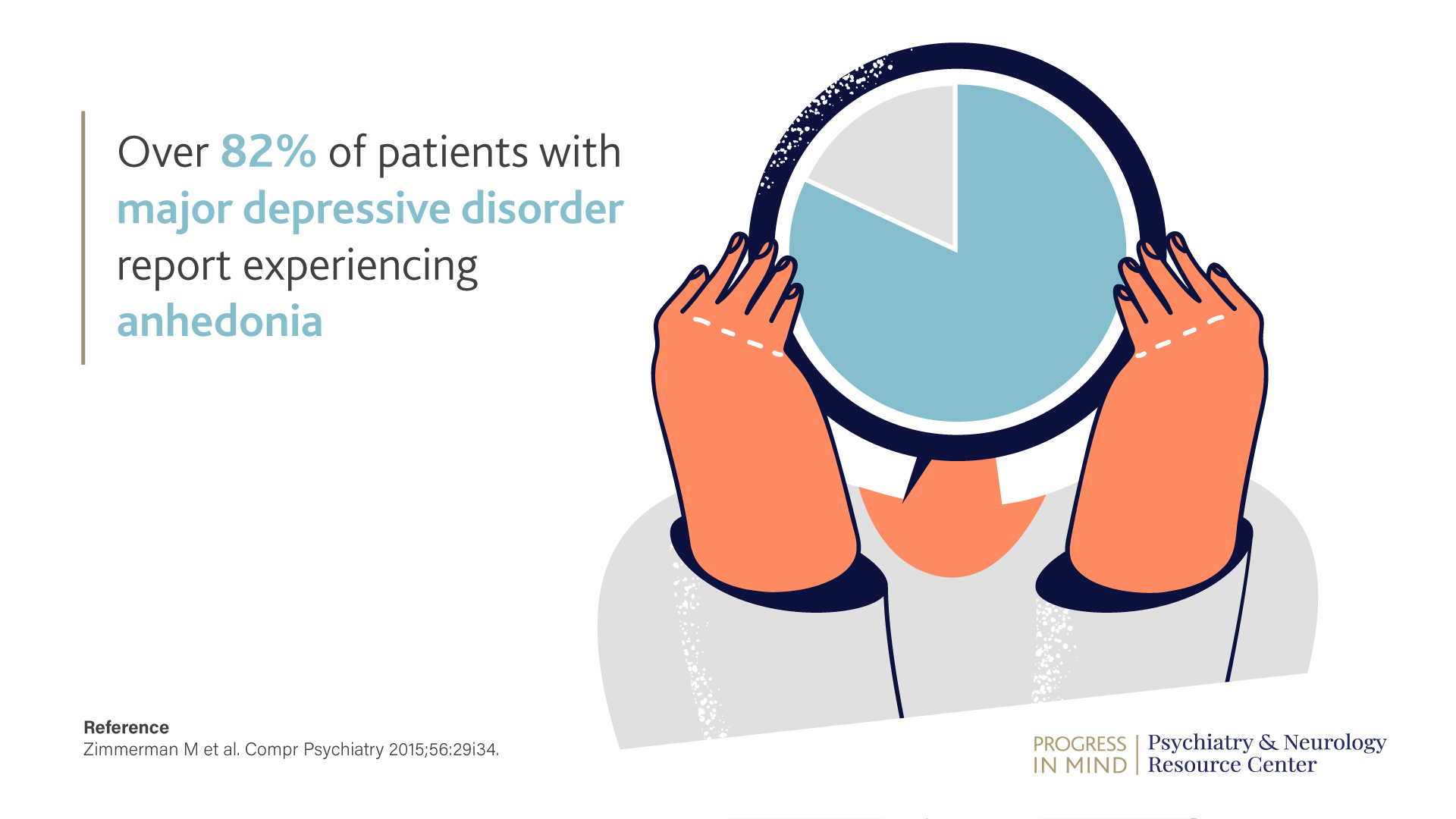There continues to be unmet needs in the treatment of patients with major depressive disorder (MDD), with many patients reporting sub-optimal health outcomes, including poor quality of life and overall functioning, despite treatment with antidepressants.1–3 Providing the best care possible could require a more granular view of the condition. By identifying and targeting specific dimensions in MDD, this may lead to improved patient-reported outcomes that could result in their full functional recovery.4 At a symposium held at the 36th annual European College of Neuropsychopharmacology (ECNP) Congress in Barcelona, an expert panel chaired by Professor Roger McIntyre (University of Toronto, Canada) discussed the topic. Dr Stavroula Bargiota (Aristotle University of Thessaloniki, Greece), Professor Andrea Fagiolini (University of Siena, Italy) and Dr Nina Schweinfurth-Keck (University Psychiatric Clinics, Basel, Switzerland) delved into the clinical significance of anhedonia in depression, the distinction between anhedonia and emotional blunting, and the association between trauma and anhedonia in MDD.4
Major depressive disorder (MDD), also known as clinical depression, is a debilitating mental health condition characterized by symptoms spanning across emotional, cognitive and physical domains. These include persistent depressed or low mood, loss of pleasure, fatigue, impaired cognitive function, and disturbed sleep or appetite.5
What are the challenges of anhedonia in major depressive disorder (MDD)?
Anhedonia is a core symptom of MDD and refers to markedly diminished interest or pleasure in response to stimuli that were previously perceived as rewarding.6 It has been implicated in disturbances to central dopaminergic reward circuit pathways, which are involved with hedonic drive, motivation, cognition and perception.7 Clinical studies have found that over 82% of patients with MDD reported experiencing anhedonia.8

Anhedonia increases the burden of MDD and has been shown to result in diminished quality of life (QoL), overall functioning and treatment response for patients with MDD.9-11 It is a strong predictor of impaired psychosocial functioning, persisting despite patients achieving symptomatic response to antidepressant treatment.11 Specifically, it is associated with:12
- Social withdrawal
- Social impairment
- Reactivity of mood
- Brooding about past events
- Diurnal mood variations
Moreover, the mental health effect of anhedonia can have a negative knock-on impact on a patient’s physical health. It may diminish their motivation to engage in physical activities and exercise, leading to a reduction in both the frequency and duration of moderate physical activity.13
While anhedonia has been shown to increase the risk of suicidality,14 predict poor treatment outcomes with antidepressant therapies,10 and negatively predict time to remission with selective serotonin reuptake inhibitor (SSRI) treatment,15 studies have highlighted a disparity between patient-reported and physician-assessed anhedonia and its impact on their functioning and QoL, indicating that physicians may be underestimating the prevalence and severity of anhedonia in their patients with MDD.9 Evidently, anhedonia is not only a potential marker of the severity of MDD but could also represent an important treatment target in the wider treatment of MDD.
Anhedonia is not only a potential marker of the severity of MDD but could also represent an important treatment target in the wider treatment of MDD
Some pharmacological treatments have been associated with improvements in anhedonia. In a systematic review evaluating the effects of pharmacological treatments on measures of anhedonia among adults with MDD, using data from 17 eligible studies, it concluded that monoaminergic antidepressants, glutamatergic agents, psychedelics, and stimulants have been associated, in varying degrees, with improvements in anhedonia.16
Anhedonia and emotional blunting: distinctions and implications for antidepressant treatment
Emotional blunting, the inability to feel positive or negative emotions, detachment, or reduced emotional responsiveness, is common in people with depression, with nearly half of patients with MMD experiencing it.9-17 Patients with anhedonia can also experience emotional blunting, however with emotional blunting both positive and negative emotions are reduced to external stimuli.9
Nearly half of patients with MDD experience emotional blunting17
Patients with MDD and emotional blunting report significant impairment in functioning, with negative effects impacting their work, home and social lives, and their overall QoL.9 Furthermore, emotional blunting is the strongest predictor of poor patient functioning and, similar to anhedonia, seems to be underestimated by physicians, with patients reporting higher severity and impact on functioning and QoL than their physicians.9
Almost half of patients with MDD considered antidepressants to be a cause of emotional blunting and almost 40% had considered stopping or had stopped taking them because of emotional side effects.9
Exploring the role of trauma in anhedonia in MDD
A history of trauma has been shown to be a risk factor for depression in adulthood and is associated with greater illness complexity. Overall, 62.5% of patients with MDD reported at least two traumatic events compared to 28.4% of control individuals. Patients with MDD and a history of trauma are at a greater risk of:18-20
- Early onset
- Relapse
- Suicidality
- Chronicity
A history of trauma has been shown to be a risk factor for depression in adulthood and is associated with greater illness complexity
Physicians may underestimate the prevalence of trauma in patients with MDD, with significantly more patients than HCPs considering trauma to be a reason for their depression and the severity of their depression.9 Emotional blunting and functional impairment are significantly greater in patients with MDD with a history of trauma than in those without, and childhood trauma is associated with elevated anhedonia due to altered core reward circuitry.9,21
Anhedonia also seems to be intimately linked with post-traumatic stress symptoms. Anhedonia was shown to increase significantly after military deployment, and higher pre-deployment anhedonia was associated with greater post-traumatic stress disorder re-experiencing symptoms post-deployment.22 In addition, a separate study of US Army and Marine veterans found that anhedonia was a significant predictor of later impairment in psychosocial functioning.23
Despite being a clinically important subpopulation, there have been few studies on the efficacy of pharmacological treatments in patients with a history of trauma. One such study demonstrated that on receiving antidepressant therapy, patients with MDD were 1.6 times less likely to achieve response or remission if they had been exposed to abuse at the age of 4–7 years.18
There seems to be an ongoing paradigm shift into building a more complex picture of MDD, not as a discrete condition, but as a collection of afflictions. A better understanding of these specific dimensions, and development of treatments aimed at them may help improve patient-reported outcomes.4
Educational financial support for this Satellite Symposium was provided by H. Lundbeck A/S.
Our correspondent’s highlights from the symposium are meant as a fair representation of the scientific content presented. The views and opinions expressed on this page do not necessarily reflect those of Lundbeck.




